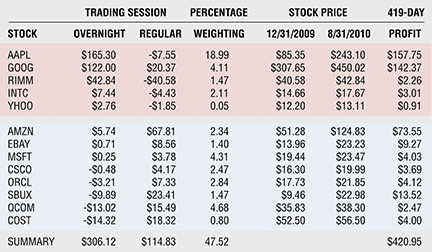TRADING TECHNIQUES
Adjust As Necessary
Trading Companies With Split Personalities
When the regular trading session gains momentum, is the market more likely to produce additional gains? Here’s how the companies in the Qqqq perform during regular trading sessions versus overnight trading sessions.
Although seven years have passed since then, the trades based on my two 2004 articles about the advantages of taking a long position in the overnight session are still delivering attractive profits. In these articles, I made a case for splitting the trading day into two separate sessions. By trading in the hours of darkness in the three years I investigated (2001–03), shares of the Nasdaq 100 Trust exchange traded fund (Qqqq), also known as the cues, made $1.69 in aftermarket activity but fell $23.61 in the regular trading session.
Since then, the cues, which were at $36.46 on December 31, 2003, ran up to a closing price of $54.46 by December 31, 2010. Despite this $18.00 advance in 1,763 trading days, the regular session (subtract the day’s closing price from its opening price) had a decline of $9.86; however, the overnight session (compute the price change in the overnight session by subtracting opening price of the next trading day from today’s closing price) was able to advance $27.86.
This article explores the possibilities of the cues making a turnaround in the regular trading session (Rts) by showing how to monitor the running performance of each trading session.
With a 62.5% weighting in the information technology sector, the cues have no exposure to the financial industry. Since they have an average trading volume of more than 100 million shares, they offer some outstanding advantages. With such vibrant activity, they normally trade with just a penny difference between the bid/ask price. This liquidity is an important feature because very few instruments offer the investor a reasonable bidding price to buy or asking price to sell outside of the regular trading session. In addition, this exchange traded fund (Etf) allows investors to participate in the collective intraday performance of the 100 companies that compose the Nasdaq 100; however, it trades with the precision of a single security.

Figure 1: OVERNIGHT VS. REGULAR TRADING SESSIONS. This table breaks down the trading action for each session. Clearly, some companies perform better (red highlight) in the overnight session whereas others shine brighter during the day (blue highlight), but thanks to three stocks, the overnight had a decisive margin. These 13 companies are responsible for nearly half of the price action in the cues.